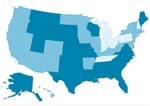opinion
Getting ready for ICD-10
■ Physicians are having to prepare for a new generation of diagnostic codes. However, the government must make sure that transition is as simple as possible.
Posted Oct. 1, 2012.
- WITH THIS STORY:
- » External links
Physicians are being hit with a slew of major changes affecting their billing and practice habits. Among them: meaningful use of electronic health records, electronic prescribing requirements, Medicare quality modifiers and HIPAA 5010 electronic claims requirements. Now there is one more to add to the pile: ICD-10.
The Dept. of Health and Human Services has declared that, by Oct. 1, 2014, anyone filing a claim with an insurer or government health program must use a new diagnostic coding system that greatly multiplies the number of codes physicians must use. The number of ICD-10-CM codes, used for documenting diagnoses, jumps to 68,000 from 14,000 in ICD-9-CM. There will be about 87,000 ICD-10-PCS procedure codes, up from a current ICD-9-PCS total of 4,000. As a Texas Medical Assn. official noted, the number of potential codes for a fractured kneecap are increasing from two to 480.
The theory behind ICD-10 is that it makes for more detailed, accurate coding for public health and quality improvement purposes, and makes diagnoses clearer for payers, which possibly could speed up the billing-and-collections cycle. However, physician organizations have said there is no clear evidence that ICD-10 will help patients.
The American Medical Association has been in the forefront in speaking out against the ICD-10 requirement as an unfunded, burdensome mandate, particularly on top of the numerous other new federal requirements under way or on the way. The AMA House of Delegates adopted a resolution in November 2011 calling for the organization to “vigorously work to stop the implementation of ICD-10 and to reduce its unnecessary and significant burdens on the practice of medicine.”
The government was adamant that the program move ahead.
But the AMA, working with others, was successful in getting HHS to push back the ICD-10 deadline. That is an unusual and meaningful example of the Dept. of Health and Human Services being persuaded to re-evaluate and change regulations it already issued. Although that is still not a sufficient delay — the AMA had asked for a pushback to at least 2015, if ICD-10 were to be instituted at all — it does give physicians more time to prepare for the new codes.
The AMA has released numerous instructional materials and guides, including online resources, books and workshops, that can help steer physicians through the ICD-10 conversion process. By the time Oct. 1, 2014, comes around, those who use the materials at least can be confident that they have done everything they can to be ready. Among the resources is an online checklist that gives practices tasks to accomplish, and an estimate on how long they will take. They are broken down into four categories:
- Organize the implementation effort (two to four weeks). During this time, practices should get familiar with ICD-10 requirements, identify personnel who will be key in the conversion, and set a preliminary budget for the work.
- Analyze the impact of implementation (two to three months). In this process, a practice looks at what work processes and electronic systems used in ICD-9 will need conversion. It also looks at what workflow changes might be necessary under ICD-10.
- Contact system vendors (one to two months, and ongoing). Practices will need to contact their electronic health system vendors to find out when they will update their systems to ICD-10, how much it will cost, and whether any new hardware will be necessary.
- Budget for implementation costs (two to four weeks, and ongoing). With the preparation well under way, at this point, practices can get a sense of what ICD-10 conversion really will cost.
Preparation well in advance is necessary, because HHS is being firm that there are no additional delays expected, and no grace period from the ICD-10 deadline. That could mean, for example, that physicians risk an interruption in their cash flow, because they won’t be able to bill for services if they haven’t converted to the new codes.
However, the onus is not merely on physicians themselves to get their practices ready. There is much that HHS can do to help doctors prepare and ensure a successful transition, something that would be in the department’s interest if it wants ICD-10 to fulfill its expectations.
For example, the AMA is pushing HHS to institute a policy that would allow advance Medicare payments to physicians in good standing with the program around the time of the transition. That way, if there are hiccups when the Oct. 1, 2014, deadline comes around, doctors will not be financially stuck until the problems get ironed out. This money would not be a loan or a bonus. Once any problems are fixed, whatever was paid out to doctors would simply be subtracted by the total billings the physicians made during the transition period.
ICD-10 and the other federal requirements coming down the pike are invariably presented in terms of benefit, but each just as certainly means a burden for physicians. The diagnostic codes are the latest example of the AMA stepping in to provide time and training to help physicians cope. Yet it remains essential that the federal government match its determination in establishing mandates with a commitment to minimizing the disruption to the doctors who actually must do the work.












